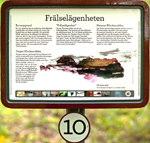Nature and Culture Trail Klockarudden
6. Beneath the Surface
Marine archaeology, as the term is used today, is a young science. It wasn’t until the middle of the 20th century that diving techniques had advanced sufficiently to enable serious underwater investigation. One of the first finds was the royal ship Vasa inside Stockholm’s harbour. The raising of the Vasa at the beginning of the 1960s was world news amongst marine archaeologists. The Vasa sank on her maiden voyage after only a few minutes. If it hadn’t been for this accident the Vasa would have sailed past here.Here, in 1986 two scuba divers discovered the barrel of a cannon. The year 1616 was inscribed on the barrel and the words “God our protector”. The cannon belonged to Duke Johan, son of King Johan III, and was probably used at the siege of Riga in 1621. No one knows how the barrel ended up at this particular spot, but we do know that a lot of cannon barrels were transported back to Sweden for recycling.Marine archaeology has made great technical progress over the last few years. We can now investigate much deeper waters than was previously possible. As a result, many wrecks have been discovered. The largest is the 16th century ship “The Mars”, which went down off the island of Öland in the south of Sweden.The bottom of the Baltic Sea has been called the world’s largest ship graveyard. Because of its cold and brackish waters it preserves old wooden vessels better than any other sea in the world. The shipworm, Teredo Navalis, which soon puts an end to old wooden hulks, doesn’t like it here. Scientists now believe there could be up to 100,000 wrecks in the Baltic. About 20,000 of these we know about and many of them are wooden vessels from the time when Sweden was a great power.To get to stop number 7, continue up towards the barbecue area.
|













